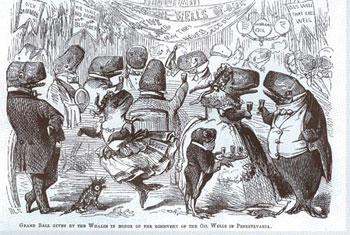“We Wail No More for Our Blubber”
In 1859, petroleum was discovered in the hills of Pennsylvania. This cheap, abundant alternative to whale oil threatened to put the New England whaling industry out of business. A popular magazine of that time published a cartoon of whales dancing at a party in honor of the new oil wells. One of the banners hanging above the scene announced, "We wail no more for our blubber."
Although petroleum did eventually replace most uses of whale oil, it did not immediately end traditional American whaling or stop the developing modern whaling industry. Norwegian whalers engineered steam powered boats and fired harpoons out of deck-mounted cannons. These new techniques eventually allowed people to chase species of whales that had swum too fast for New England ships.
Even before the discovery of petroleum, American consumers had begun to use gas and kerosene made from coal to light a growing number of city streets, homes, and businesses. New Bedford, with its easy access to whale oil, took advantage of this new raw material and opened a gas plant in 1853. Editors of the local Whalemen’s Shipping List bemoaned this new threat to whaling, explaining "I don’t know what gas is—all I know is that it ain’t blubber."

Sag Harbor Whaling and Historical Museum